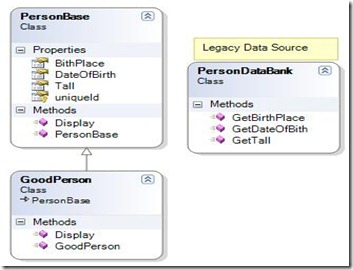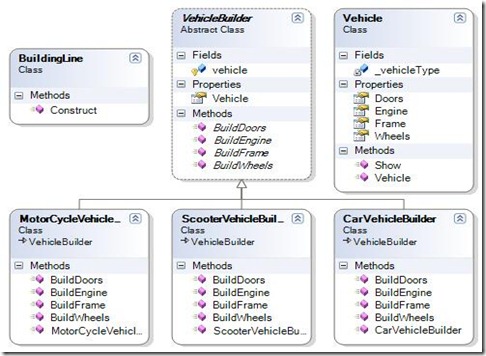static void Main(string[] args)
{
VehicleBuilder builder;
// Create BuildingLine with vehicle builders
BuildingLine buildingLine = new BuildingLine();
// Construct and display vehicles
builder = new ScooterVehicleBuilder();
buildingLine.Construct(builder);
builder.Vehicle.Show();
builder = new CarVehicleBuilder();
buildingLine.Construct(builder);
builder.Vehicle.Show();
builder = new MotorCycleVehicleBuilder();
buildingLine.Construct(builder);
builder.Vehicle.Show();
// Wait for user
Console.ReadKey();
}
class BuildingLine
{
// Builder uses a complex series of steps
public void Construct(VehicleBuilder vehicleBuilder)
{
vehicleBuilder.BuildFrame();
vehicleBuilder.BuildEngine();
vehicleBuilder.BuildWheels();
vehicleBuilder.BuildDoors();
}
}
class CarVehicleBuilder : VehicleBuilder
{
public CarVehicleBuilder()
{
vehicle = new Vehicle(“Car Vehicle”);
}
public override void BuildFrame()
{
vehicle.Frame = “Car Vehicle Frame”;
}
public override void BuildEngine()
{
vehicle.Engine = “3000 CC capicity”;
}
public override void BuildWheels()
{
vehicle.Wheels = 4;
}
public override void BuildDoors()
{
vehicle.Doors = “4”;
}
}
class MotorCycleVehicleBuilder : VehicleBuilder
{
public MotorCycleVehicleBuilder()
{
vehicle = new Vehicle(“MotorCycle Vehicle”);
}
public override void BuildFrame()
{
vehicle.Frame = “MotorCycle Vehicle Frame”;
}
public override void BuildEngine()
{
vehicle.Engine = “300 CC Capacity”;
}
public override void BuildWheels()
{
vehicle.Wheels = 2;
}
public override void BuildDoors()
{
vehicle.Doors = “0”;
}
}
class ScooterVehicleBuilder : VehicleBuilder
{
public ScooterVehicleBuilder()
{
vehicle = new Vehicle(“Scooter Vehicle”);
}
public override void BuildFrame()
{
vehicle.Frame = “Scooter Vehicle Frame”;
}
public override void BuildEngine()
{
vehicle.Engine = “50 CC Capacity”;
}
public override void BuildWheels()
{
vehicle.Wheels = 2;
}
public override void BuildDoors()
{
vehicle.Doors = “0”;
}
}
class Vehicle
{
private string _vehicleType;
// Constructor
public Vehicle(string vehicleType)
{
this._vehicleType = vehicleType;
}
public string Frame { get; set; }
public string Engine { get; set; }
public int Wheels { get; set; }
public string Doors { get; set; }
public void Show()
{
Console.WriteLine(“\n—————————“);
Console.WriteLine(“Vehicle Type: {0}”, _vehicleType);
Console.WriteLine(” Frame : {0}”, this.Frame);
Console.WriteLine(” Engine : {0}”, this.Engine);
Console.WriteLine(” #Wheels: {0}”, this.Wheels);
Console.WriteLine(” #Doors : {0}”, this.Doors);
}
}
abstract class VehicleBuilder
{
protected Vehicle vehicle;
// Gets vehicle instance
public Vehicle Vehicle
{
get { return vehicle; }
}
// Abstract build methods
public abstract void BuildFrame();
public abstract void BuildEngine();
public abstract void BuildWheels();
public abstract void BuildDoors();
} |



